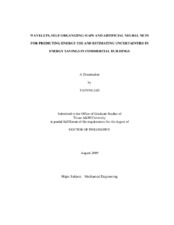| dc.contributor.advisor | Subbarao, Kris | |
| dc.creator | Lei, Yafeng | |
| dc.date.accessioned | 2010-01-15T00:17:07Z | |
| dc.date.accessioned | 2010-01-20T21:15:45Z | |
| dc.date.available | 2010-01-15T00:17:07Z | |
| dc.date.available | 2010-01-20T21:15:45Z | |
| dc.date.created | 2009-08 | |
| dc.date.issued | 2010-01-14 | |
| dc.identifier.uri | https://hdl.handle.net/1969.1/ETD-TAMU-2009-08-7120 | |
| dc.description.abstract | This dissertation develops a "neighborhood" based neural network model
utilizing wavelet analysis and Self-organizing Map (SOM) to predict building baseline
energy use. Wavelet analysis was used for feature extraction of the daily weather
profiles. The resulting few significant wavelet coefficients represent not only average
but also variation of the weather components. A SOM is used for clustering and
projecting high-dimensional data into usually a one or two dimensional map to reveal the
data structure which is not clear by visual inspection. In this study, neighborhoods that
contain days with similar meteorological conditions are classified by a SOM using
significant wavelet coefficients; a baseline model is then developed for each
neighborhood. In each neighborhood, modeling is more robust without unnecessary
compromises that occur in global predictor regression models.
This method was applied to the Energy Predictor Shootout II dataset and
compared with the winning entries for hourly energy use predictions. A comparison between the "neighborhood" based linear regression model and the change-point model
for daily energy use prediction was also performed.
We also studied the application of the non-parametric nearest neighborhood
points approach in determining the uncertainty of energy use prediction. The uncertainty
from "local" system behavior rather than from global statistical indices such as root
mean square error and other measures is shown to be more realistic and credible than the
statistical approaches currently used.
In general, a baseline model developed by local system behavior is more reliable
than a global baseline model. The "neighborhood" based neural network model was
found to predict building baseline energy use more accurately and achieve more reliable
estimation of energy savings as well as the associated uncertainties in energy savings
from building retrofits. | en |
| dc.format.mimetype | application/pdf | |
| dc.language.iso | en_US | |
| dc.subject | wavelet analysis | en |
| dc.subject | self-organizing maps | en |
| dc.subject | neural networks | en |
| dc.subject | baseline energy model | en |
| dc.title | Wavelets, Self-organizing Maps and Artificial Neural Nets for Predicting Energy Use and Estimating Uncertainties in Energy Savings in Commercial Buildings | en |
| dc.type | Book | en |
| dc.type | Thesis | en |
| thesis.degree.department | Mechanical Engineering | en |
| thesis.degree.discipline | Mechanical Engineering | en |
| thesis.degree.grantor | Texas A&M University | en |
| thesis.degree.name | Doctor of Philosophy | en |
| thesis.degree.level | Doctoral | en |
| dc.contributor.committeeMember | Claridge, David E. | |
| dc.contributor.committeeMember | Haberl, Jeff S. | |
| dc.contributor.committeeMember | O’Neal, Dennis L. | |
| dc.type.genre | Electronic Dissertation | en |


